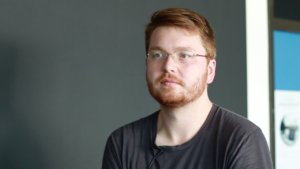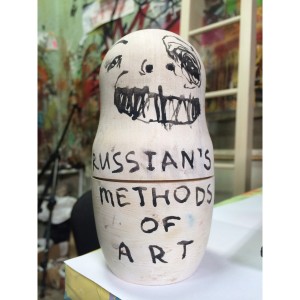Quite early in my work I have already dealt with the question of the authorship and associated the question of the self-conception of an artist. Since I have never had an art education, it was also a very strong experimental space that I have powered myself, regarding the content and these questions. With different characteristics. I have initiated very early artworks, where I was depending on others that were involved causally or essentially in the emergence of the work. The most obvious were, to mention two or three examples in this case: First „Megazeichen“. A high-rise-project, where the staff in the house itself switched the light on and off. A total of 700 employees of a company. This was prepared between 1987 and 1989 and in 1990 it took place. A very tedious process. One can imagine, I guess. And regarding the self-conception this means: the artwork is created in the process and in the dialogue. Sometimes several people are involved, as with the larger projects that I have mentioned. Or just a few, here in the studio with Sebastian Freitag and Inka Christmann and my wife Michele, who are all involved in these processes in a different way and in different intensity. According to my understanding the idea of the author has something to do with a concept of art which is being handed on. That one wishes an author behind an artwork. It is much more difficult, and this is also shown by the development of 12 Ballade for Huguenot House, which was a great success in Kassel, but now ended up in the collection of Pinault by Theaster Gates. And all who have been working on it – never mind in which position, I invited some of them to the KHM last year – I have visited some of them in Chicago in May… And it seems as if success is less noticeable in groups, and even less in communities that are not that clearly characterized. But rather becomes apparent with a single person. And that makes it difficult and this makes it difficult with the authorship. One always has to know exactly what to give back to the people in the process . And I see it this way: where does the trigger come from? Where does this first impulse come from? I observe certain situations and sometimes I make a note that I want to do something at a certain point, because I believe that something can be done, which pushes my work at this point. A discussion, a question, an attention that gets there. And maybe it is even connected to my person for a moment, but then it diffuses into something what we later see as a discourse or a contribution to a discussion. I try to negotiate what I do outside of my person. This means the inference to the artwork, for example Solidarity Grid is not my project. This is my contribution. I see this all the time as in working towards a larger idea or a co-creation on a bigger idea but not so much the question: How is this now connected with me? What I find very pleasant is that a lot of people know projects, for example Synagoge Stommeln or Megazeichen but do not know the author. And this is correct because indeed many authors have contributed. And I honestly prefer that it is more a general perception, that such an intervention is possible, that one can develop existing architecture without additional resources to a sculptural aspect. Or a synagogue can be a strong socio-political character, because one exhibits nothing in it. So things like that. This continues in teaching. There are no classes at the KHM not like in the Art Academy in Düsseldorf. And I support that, by abstracting it even further by saying: there is this „-1/MinusOne Experimental Lab“ which I co-founded with students who have recognized the need for a space to exhibit, to test and to work. And I am, so to speak, a co-founder. And of course this is something different than calling a class „Kuball“ or whatever. I think this also reflects my attitude a bit.
In meiner künstlerischen habe ich mich schon relativ früh mit der Frage der Autorenschaft beschäftigt und damit verbunden natürlich auch mit der Frage nach einem künstlerischen Selbstverständnis. Da ich nie selber eine künstlerische Ausbildung gemachte habe, war es für mich auch ein sehr starker experimenteller Raum, den ich inhaltlich und auch von der Frage her selbst angeführt habe. Mit unterschiedlichen Ausprägungen. Ich habe sehr früh Arbeiten initiiert, wo ich mich selber bewusst davon abhängig gemacht habe, dass Andere an dem Entstehen des Werkes ganz maßgeblich oder ursächlich beteiligt sind. Am deutlichsten, um hier zwei, drei Beispiele zu nennen: Zum einen „Megazeichen“. Ein Hochhausprojekt, wo die Mitarbeiter im Haus selber das Licht an und ausgeschaltet haben. Insgesamt 700 Mitarbeiter eines Unternehmens. Das war zwischen 1987 und 1989 vorbereitet und 1990 wurde es dann realisiert. Ein sehr langwieriger Prozess. Das kann man sich ja fast schon auch vorstellen. Und das heißt vom Selbstverständnis her: Die Arbeit entsteht im Prozess und im Dialog. Mal sind mehrere Leute beteiligt, wie jetzt bei den größeren Projekten, die ich angedeutet habe. Oder eben jetzt auch hier im Atelier mit Sebastian Freitag und Inka Christmann und meiner Frau Michele, die eigentlich alle an diesen Prozessen, in unterschiedlicher Art und in unterschiedlicher Intensität, teilnehmen. Die Idee des Autos hat, nach meinem Verständnis, etwas mit einem tradierten Kunstbegriff zu tun. Dass man sich hinter einem Werk eben einen Autor wünscht. Es ist viel schwieriger, und das merkt man jetzt auch bei der Weiterentwicklung von „12 Ballade for Huguenot House“, was da in Kassel so ein großer Erfolg war, landet jetzt in der Sammlung von Pinault unter Theaster Gates. Und alle die daran, in welcher Rolle auch immer mitgearbeitet haben – einige von denen hatte ich an die KHM eingeladen im Sommer letzten Jahres. Ich habe auch einige von denen jetzt im Mai in Chicago besucht im Old Chesterhouse. Es scheint so zu sein, dass der Erfolg sich letztlich weniger an Gruppen, und noch schwieriger an Gemeinschaften, die gar nicht so deutlich zu charakterisieren sind, zeigt. Sondern sich eben gerne abzeichnet oder abträgt an einer Person. Und das macht es schwer und deswegen ist das mit der Autorenschaft schwierig. Man muss also im Prozess eigentlich immer genau wissen, was man den Leuten zurück gibt. Und ich sehe das so: Woher kommt der Impuls? Woher kommt dieser erste Anstoß? Ich beobachte ja bestimmte Situationen und manchmal mache ich mir eine Notiz, dass ich an der und der Stelle etwas unternehmen möchte, weil ich glaube, dass da etwas getan werden kann, was meine Arbeit an dieser Stelle anschiebt. Eine Diskussion, eine Frage, eine Aufmerksamkeit, die dadurch hinkommt. Und vielleicht sogar verbunden mit meiner Person für einen kurzen Augenblick aber dann diffundiert sich das in etwas, was wir dann später als einen Diskurs oder Diskussionsbeitrag wahrnehmen. Ich versuche, das was ich mache außerhalb meiner Person zu verhandeln. Das heißt der Rückschluss auf die Arbeit, also beispielsweise „Solidarity Grid“ ist jetzt nicht mein Projekt. Das ist mein Beitrag. Ich sehe das immer so als ein Zuarbeiten auf eine größere Idee hin oder was Mitgestalten auf eine größere Idee hin und nicht jetzt so sehr die Frage: Wird das jetzt mit mir verbunden? Was ich sehr angenehm finde ist, dass eine Menge Leute, die Projekte kennen – zum Beispiel „Synagoge Stommeln“ oder „Megazeichen“ – aber den Autor dazu nicht kennen. Und das ist ja auch richtig, weil in der Konsequenz ja auch viele AutorInnen mitgewirkt haben. Und da ist mir das ehrlich gesagt lieber, dass sich das sozusagen auf so ein allgemeineres Wahrnehmen, dass so eine Form von Intervention möglich ist, dass man bestehende Architektur ohne zusätzliche Mittel zu einem skulpturalen Aspekt entwickeln kann. Oder eine Synagoge zu einem starken sozio-politischen Zeichen werden kann, weil man eben nichts darin ausstellt. Also solche Sachen. Das setzte sich ja bei mir auch in der Lehre fort. Es gibt ja keine Klassen an der KHM anders als an der Kunst Akademie in Düsseldorf. Und ich unterstütze das, indem ich das noch mal weiter abstrahiere, indem ich sage: es gibt dieses „-1/MinusEins Experimentallabor“, das ich mitgegründet habe zusammen mit StudentInnen, die die Notwendigkeit erkannt haben, dass man an dieser Stelle eben einen Ort braucht, wo man ausstellen kann, sich ausprobieren kann, arbeiten kann. Und ich bin dann sozusagen Mitgründer. Und das ist natürlich etwas anderes als wenn ich sage das ist die Klasse „Kuball“ oder wie auch immer. Ich glaube das spiegelt auch so ein bisschen meine Haltung.

















